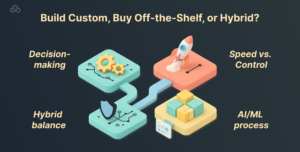Introduction
Every executive asks the same thing in different words: do we build a custom AI stack, buy an off-the-shelf solution, or do a bit of both? In practice, teams want speed yesterday and control tomorrow. That’s why most ai/ml development services land you on a hybrid: start with off-the-shelf to ship value fast, then layer targeted custom pieces where they change outcomes or unit economics. It’s not flashy, but it’s sane. An ai development service will pressure-test the use case, check data readiness, map compliance and latency, and only then propose custom. Meanwhile, ai app development services make sure the UX, guardrails, and KPIs aren’t an afterthought. When advanced ai services and the best ai services agree, it’s usually this: start simple, design for optionality.
Consultant’s Decision Framework
AI consultants don’t start with models; they start with drivers:
-
Differentiation: Is this core to how you win? If yes, custom or hybrid earns the right to exist. If it’s back-office hygiene, off-the-shelf is often enough.
-
Data readiness: Clean, labeled, accessible, and governed? If you’re still herding CSVs, AI/ML development services will push for off-the-shelf or a thin hybrid until your pipelines mature.
-
Compliance & auditability: PHI/PII, regional residency, or strict attestations tilt toward custom/hybrid with policy engines and private endpoints.
-
Change velocity & model drift: Rapidly shifting content or nomenclature? Prefer hybrid with RAG and fast re-indexing.
-
Unit economics: High query volume or latency-sensitive tasks demand caching, routing, and sometimes small fine-tunes.
Mini scorecard: If you answer “yes” to three or more of these, (a) strict compliance, (b) messy domain language, (c) sub-500ms targets, (d) cost sensitivity at 10k+ daily calls, (e) explainability required, start hybrid/custom. Otherwise, start off-the-shelf and reassess at 60–90 days. This is exactly how mature ai development service partners keep you from over-engineering day one.
Driver → Default Bias
|
Driver |
Evidence |
Bias |
|
PHI/PII + audit |
SOC 2/HIPAA scope |
Hybrid/Custom |
|
Need value in 6 weeks |
Exec OKRs |
Off-the-shelf |
|
Latency < 500ms |
Contact center, agent tools |
Hybrid |
|
Cost at scale |
10k–100k QPS plans |
Custom/Hybrid |
|
Proprietary IP |
Unique data moat |
Custom |
Cost & ROI in 12–24 Months
Here’s the simple view: off-the-shelf gets you results fast but the monthly bill stays higher; custom takes longer to build but can be cheaper per request once volume grows; hybrid starts fast and then lowers cost with caching and retrieval over your own data. Good AI/ML development services will help you pick the path that fits your timeline, data, and budget.
|
Item |
Off-the-Shelf |
Hybrid |
Custom |
|
Team effort |
Low |
Medium |
High |
|
Vendor fees (seats/tokens) |
High |
Medium |
Low–Medium |
|
Your infra cost (VPC/GPUs/storage) |
Low |
Medium |
High |
|
Compliance work |
Shared with vendor |
Higher |
Highest |
|
Observability & evaluations |
Basic–Medium |
Medium–High |
High |
|
Time to value |
Weeks |
6–10 weeks |
Slow start |
|
Long-run cost per request |
Higher |
Medium |
Lower (with scale) |
A quick example makes it clear: at ~20k requests/day, an off-the-shelf setup might be about $12k/month; a hybrid with ~50% cache hit rate can land near $6k/month; a custom small-model + RAG build could be ~$6.6k/month after an upfront $60k build, breaking even with off-the-shelf in roughly 11 months. An experienced ai development service or ai app development services team will show these trade-offs on a simple dashboard, so you can choose, adjust, and scale with confidence using the best ai services and the advanced ai services you need.
Architecture & Security on One Page
Three patterns you’ll actually deploy:
-
Off-the-shelf: SaaS-embedded AI (CRM/ERP copilots), or vendor LLM via private endpoints. Minimal engineering. Great for pilots.
-
Custom: RAG with domain embeddings, a policy engine for PII suppression, evaluators to catch hallucinations, and, where latency matters, a small model fine-tune.
-
Hybrid (default recommendation): An LLM router that chooses providers by task, plus caching, observability, and a retrieval layer over your data. Ai app development services usually start here: thin glue, strong guardrails, low regret.
Security must-haves regardless of path:
-
Network isolation (VPC peering), KMS for keys and secrets, policy-as-code for governance.
-
Prompt-injection defenses (input sanitation, tool-use allowlists).
-
PII-aware logging with role-based access and retention policies.
-
Vendor diligence: data residency, training-data use, and audit rights.
Portability without pain:
-
Keep embeddings portable (document your model choice and vector math), wrap LLMs behind a small internal API, and invest in evals first, once you can measure task success consistently, swapping providers is less scary. This is the playbook advanced ai services deliver when they say “avoid lock-in” and actually mean it.
Case Snapshots + A 90-Day Playbook
Short, specific, and boringly real:
-
SMB Support (Off-the-shelf first): A B2C retailer added a SaaS copilot in their helpdesk. With basic workflows and no PII exposure, AI/ML development services recommended off-the-shelf. Result: ~20–22% AHT reduction in 6 weeks; deflection up 14%. The follow-on? A tiny hybrid layer to cache top intents and cap token spend.
-
Regulated Mid-Market (Hybrid): Health-adjacent services firm needed strict auditability. Ai app development services built domain RAG with a policy engine and private endpoints. Zero PII incidents in audit; payback ~7 months as cache hit rate rose above 60%.
-
Global Enterprise (Custom where it counts): For catalog normalization at massive scale, a small fine-tune plus high-quality retrieval cut costs ~60% vs raw API calls at volume. The ai development service kept a router fallback to a larger model for edge cases, sane, safe, measurable.
Technical FAQs
When is a fine-tuning over RAG + prompt engineering justified?
Labels are good, latency or token costs are dominant, and your domain language is stable. AI/ML development services typically prefer RAG with tight evals prior to any fine-tuning if terminology drifts on a weekly basis.
Recommended stack for routing, caching, and observability?
A lightweight LLM router (policy/rules + telemetry), a semantic cache (embedding-indexed responses), and full observability (traces, cost per call, refusal/hallucination rates). Many advanced ai services pair this with a prompt registry and offline eval harness.
How do we prevent prompt injection and tool abuse in agents?
Constrain tools with allowlists, validate inputs/outputs, enforce content policies, and run policy-as-code checks pre- and post-tool call. Ai app development services also recommend canary prompts and synthetic attack suites during CI.
How do we estimate 24-month TCO for Hybrid vs pure API?
Model volume growth, cache hit rates (30% → 60% over time), token pricing, provider mix, and staff costs. The best ai services will show three curves (Off-the-shelf, Hybrid, Custom) with sensitivity on cache and latency targets.
What data contracts are non-negotiable?
Producer SLAs (freshness, schema), PII tagging, lineage, and consent metadata. Without this, ai development service partners cannot guarantee audit outcomes or stable retrieval quality.
How do AI/ML development services structure build-operate-transfer (BOT)?
Phase 1: discovery and pilot; Phase 2: operate with SLOs and cost caps; Phase 3: transfer with playbooks, IaC, and training. You keep the keys, the logs, the evals, portability by design.
Ship Value Now, Earn Control Later
You don’t have to choose forever on day one. Ship an off-the-shelf pilot, measure real task success, then add a thin hybrid layer for caching, routing, and RAG over your data. Go custom where the ROI is obvious, latency, scale, or differentiation. Work with AI/ML development services that prove results with dashboards, not slides. The best ai services keep your options open; the right ai development service turns that optionality into lower costs and higher confidence. Start small, instrument everything, and build the parts that matter only when the numbers say so.
Do you like to read more educational content? Read our blogs at Cloudastra Technologies or contact us for business enquiry at Cloudastra Contact Us.

